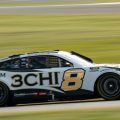EchoPark Speedway, formerly known as Atlanta Motor Speedway, becomes the first track to host a second event for the 2025 NASCAR Cup Series season.
As a drafting track, there is a huge amount of variance, with some races here literally being totally random, while others have up to about 25% of the variance in the finishing order predicted by pre-race data, leaving 75% unexplained by any normal factors.
Even 25% predictability is still quite low and would put it below all other ovals and road courses. When variance is the name of the game, we rely on two things:
- Ownership leverage
- Place differential
Because even in the 25% predictable races, it still means there are about 30-35 cars that can finish almost anywhere in the field, all the way from first to 40th.
EchoPark does pose a unique quirk among drafting track races in that a dominator can be viable, given there are 260 laps instead of at most 200 at all other drafting track races, and the dominator often finishes near the front.
Finally, EchoPark has been very Jekyll-and-Hyde-like in its seven races under the current configuration. Three races have had in the neighborhood of 25% predictability, three hovering at 0%, and one in between at around 13%.
That means if you’re max entering, I’d suggest two sets of builds. One for total chaos and one with a bit (but not a ton) more predictability in mind.
In the chaos set, forget about dominators; treat it like a pure superspeedway lineup build where place differential and finishing position, leveraged against projected ownership, are the center of the universe.
In the other set, you can target at most one dominator per lineup, drastically reduce your usage of the bottom-tier cars, and focus a bit more on who you think will have solid finishes. That said, place differential will still be king in these lineups, but it won’t necessarily be your only thought.
As always, you can check out my NASCAR projections in the NASCAR Models on FantasyLabs, complete with floor, ceiling, median, and ownership projections.
My projections, along with Stephen Young’s from RotoGrinders, are available in our new NASCAR DFS package. You can read more about what the package entails here.

Let’s not skip the best part — my Perfect% metric — a metric that tells you how often certain racers appear in the optimal lineup when running 10,000 race simulations.
And don’t forget about the tools that FantasyLabs has to offer, like our Lineup Optimizer to effortlessly create up to 300 lineups or our Lineup Builder if you like to hand-build your lineups.
So, without further ado, here’s my strategy guide and NASCAR DFS picks for the Quaker State 400 at EchoPark Speedway.
Quaker State 400 DraftKings DFS Tournament Picks
There are four specific drivers I want to be intentionally overweight on.
Cody Ware ($4900): For the 50% of your builds that are pure chaos, Cody Ware has plenty of utilization, and that’s reflected in his 10% optimal number. That means in those 50% of your chaos builds, you’ll want closer to 20% Cody Ware, and in the other 50% of your lineups, you’ll want closer to 0% Cody Ware.
I don’t think you need to go that drastic, but something like 15% and 5% would make sense to get a 10% blended average.
Noah Gragson ($6200): My model is probably too bullish on Gragson, but certainly I agree it’s directionally correct. The Front Row Motorsports driver has been in the conversation for drafting track wins before.
That’s despite an abysmal track history at this specific track, where he’s run into a major incident in six of his seven starts.
That’s bad luck, but that also should keep his usage down to where we can take advantage by going overweight on him in a race with a high amount of randomness.
Connor Zilish ($6600): Any time you can get a driver in strong equipment starting this far back at an ownership discount (since he’s a rookie), you take it.
Updated on 12/15/25

Quaker State 400 DraftKings DFS Tournament Leans
Since nearly every driver is in play (aside from David Start), for me, a “lean” in this context will be a driver I like being slightly overweight on compared to the field.
For most of these, you can just directly compare Perfect% to projected ownership, and that’ll work, but I do think there’s a chance my ownership projections are too low on Ricky Stenhouse Jr., Ross Chastain, and Denny Hamlin, so I wouldn’t consider Stenhouse and Chastain leans through that method.
Quaker State 400 DraftKings DFS Dominators
Remember, in about 50% of your lineups you shouldn’t worry about a dominator, and then in the other 50% of your lineups you should have 0 or 1 dominator.
Drivers starting outside the top third of the field don’t count as a dominator (even if they dominate) because they are viable as place differential plays anyway. So inside those first five or six rows, the only dominators I’d worry about, in order of preference, are
- Austin Cindric (4)
- Joey Logano (1)
- Ryan Blaney (3)
- Brad Keselowski (6)
Daytona 500 DraftKings DFS Paul Menard Pick of the Week!
Todd Gilliland is this week’s PMPOTW with a 6.5% projected ownership from me and an even lower 3.2% from StevieTPFL.
I have Gilliland at 8.7% optimal, and I think that’s a bit low given his past dominance here. My model is probably overvaluing, just a touch, year-to-date performance so I’d play him closer to 10% and feel good about the leverage we’ll get on Gilly.
Daytona 500 DraftKings DFS Cash Game Strategy
Instead of picks, I’ll say the same thing I do for every drafting track. Roster drivers with great equipment who have a lower chance of encountering issues, starting in the back.
That eliminates David Starr, BJ McLeod, and Cody Ware as cash game considerations just in case we get a more predictable race.
Other than that, choose anyone you like from the back of the starting grid.
Pictured: Noah Gragson
Photo credit: Imagn





